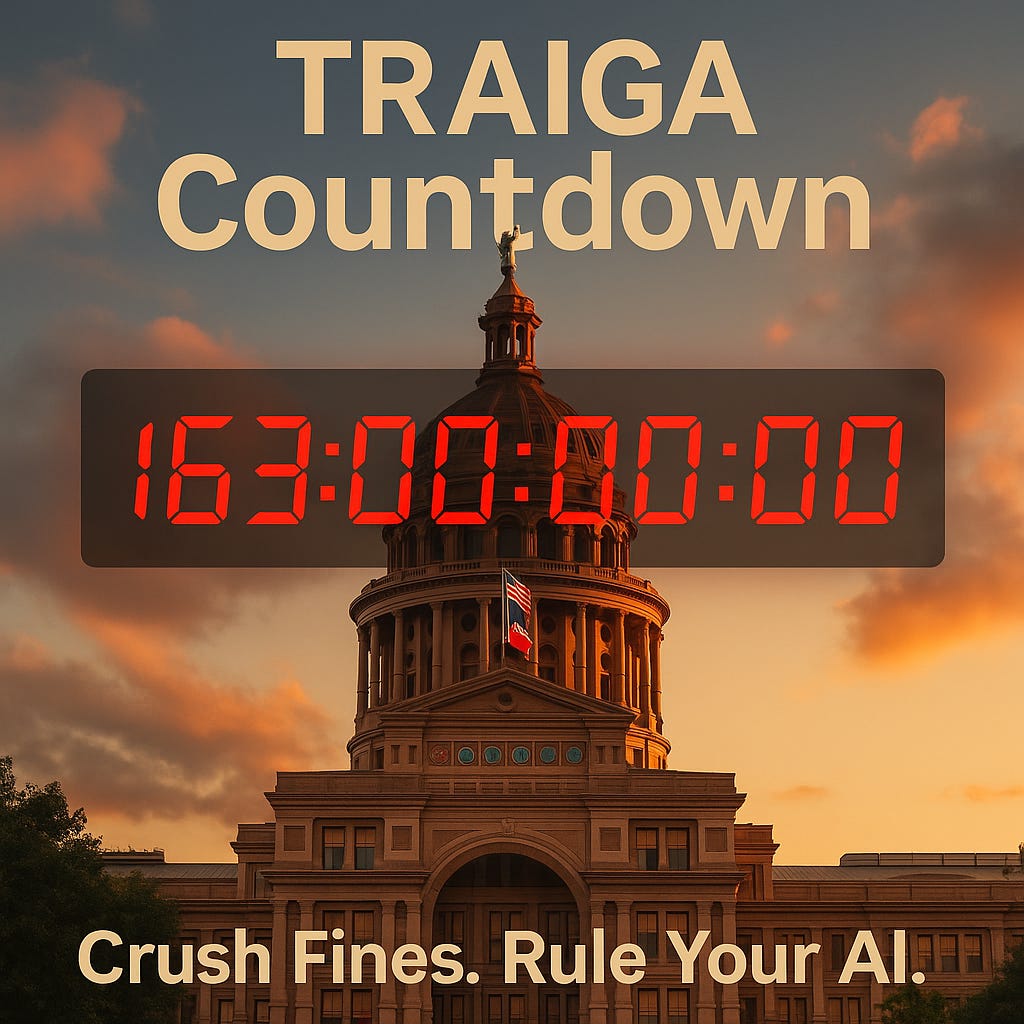TRAIGA compliance Countdown: Texas AI Law Playbook
Beat the TRAIGA Clock—Crush Fines and Rule Your AI Before 2026
Artificial intelligence will not wait for your legal team. TRAIGA compliance moved from rumor to statute on June 22, 2025, and every enterprise touching Texas has until January 1, 2026 to prove it can govern its algorithms. The clock runs while Colorado’s AI Act (aka Colorado Consumer Protections for AI) looms one month later. Ignore the clock and you hand regulators the pen to write your next budget. Tackle it head-on and you create a market signal that trust beats speed. This playbook gives you the facts, the gaps, and the moves that keep innovation alive without setting legal hair on fire.
1. What TRAIGA Covers and Why It Matters
Texas aimed for impact, not headlines. The law bans specific abuses such as AI that pushes users toward self‑harm (<cough>Character.ai</cough>, suppresses constitutional rights, discriminates with intent, or manufactures illicit deepfakes. One clear number drives urgency. Penalties rise to $200,000 for each incurable violation. The Attorney General alone enforces the Act, but they must offer a 60‑day cure period first. That window is mercy for firms who are prepared. If your firm isn’t prepared? Good luck meeting that cure period. The statute also forces any business that lets consumers chat with an AI to reveal the bot at first contact. Hospitals must warn patients when AI guides diagnosis unless an emergency overrides. Transparency rules look light, yet Texas reserves the right to demand full model documentation during an investigation. Treat “minimal” as marketing, not reality.
2. Colorado AI Act versus TRAIGA: Same Year, Different Game
Colorado attacks outcome risk; Texas attacks malicious intent. Colorado labels any system that shapes “consequential decisions” in jobs, lending, housing, or health as high‑risk. Developers must publish impact assessments, bias tests, and public summaries. Deployers must notify subjects before the algorithm renders judgment and offer a human appeal path. Fines track consumer‑protection law with no cure period.
Texas skips that bureaucracy, but its sandbox has teeth. You may test a model for 36 months under lighter rules, yet you must file quarterly reports and open your kimono if the Department of Information Resources comes knocking.
Bottom line: Colorado burdens process; Texas punishes bad faith. Multistate enterprises must meet the stricter Colorado documentation bar to avoid a compliance split‑brain.
3. Compliance Timeline and State AI Compliance Deadlines
Circle three milestones:
January 1, 2025 – TRAIGA takes effect.
February 1, 2026 – Colorado AI Act takes effect.
Q2 2026 – Utah, California, and other states finalize sector‑specific rules.
You can’t wait for last‑minute rulemakings. The Texas Attorney General will launch a consumer complaint portal by November 2025. Colorado’s Attorney General already funds an Algorithmic Justice Unit. Expect early test cases by mid‑2026 to set enforcement tone. Your playbook must treat September 30, 2025 as an internal freeze date with policies signed, inventories complete, and first‑round audits finished.
4. AI Governance Roadmap That Works Across States
A single framework beats a patchwork. Map every model your firm builds, buys, or embeds. Tag each by decision criticality, user population, and jurisdiction. Adopt NIST AI RMF or ISO 42001 as the operating system, then bolt on RockCyber’s CARE Framework for policy depth and RISE Framework for business alignment. For each high‑impact system:
Perform a bias and security threat model.
Record purpose, data sets, limitations, and red‑team findings.
Attach a plain‑language summary for internal audit.
Draft consumer disclosures now; push to production UI by October.
Build a 60‑day cure runbook that assigns legal, engineering, and comms owners.
Texas gives a safe harbor if you detect and fix your own mess before the AG calls. Treat that as a performance metric.
Go read “Navigating the Triad: How RISE and CARE Frameworks Transform AI Strategy and Governance” for more details on RISE and CARE.
Navigating the Triad: How RISE and CARE Frameworks Transform AI Strategy and Governance
Let me get something clear right off the bat.
5. Seven Moves to Nail Your TRAIGA compliance Checklist
Kill prohibited use cases: purge any feature that nudges self‑harm or illegal behavior. (No 💩, but it has to be said!)
Flag manipulative content risk: run LLM guardrails that block malicious prompts.
Harden audit trails: log inputs, model version, and decision outputs for 10 years.
Automate disclosure banners: insert AI badges in chat flows by default.
Embed human‑in‑the‑loop overrides: especially for healthcare and finance.
Stage cure drills: rehearse a regulator notice twice before January.
Pass the Colorado bar by passing the strictest bar: align high‑risk systems to Colorado’s documentation standard even if only Texas hosts them.
Key Takeaway: Early, disciplined governance turns state AI regulation chaos into a competitive edge and keeps the fine print off your income statement.
Call to Action
Book a Complimentary Risk Review. Subscribe for more AI security and governance insights with the occasional rant.




